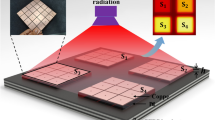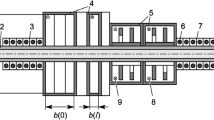Abstract
Microwave ovens function through the emission of electromagnetic waves, which reflect off the walls of the cavities causing local fluctuations to the electromagnetic field. In multimode cavities, multiple hotspots are generated due to the presence of various nodes, causing the localized overheat. Understanding the location of the hotspots is important to improve the heating efficiency and homogeneity of the microwave. This work aimed to propose an innovative technique for mapping the hotspots inside the multimode cavities microwave, using a resistive sheet made of polypropylene and activated carbon in contents of 5, 10 and 20%. To validate the experimental mapping technique, numerical simulations were used to predict the electromagnetic fields inside the cavity, and the simulations were then compared to the experimental result. The numeric models were validated through the experimentally determined output power. The experimental mapping results showed it was possible to reproduce clear and easy identifiable hotspots in different heights inside cavities using resistive sheets with activated carbon contents of 10 and 20%. The numerical simulations showed results for the output power that were statistically equal to the experimental results, validating its application for the prediction of the electromagnetic and thermo fields. Comparing the experimental and numerical mapping of the hotspots, a consistent match was verified between the generated profiles. Thus, the developed mapping technique managed to predict adequately the hotspots inside microwave cavities, which is useful for applications such as scale-ups and the optimization of industrial cavities.
Graphic abstract








Similar content being viewed by others
Availability of data and material
The journal encourages authors, where possible and applicable, to deposit data that support the findings of their research in a public repository. Datasets that are assigned digital object identifiers (DOIs) by a data repository may be cited in the reference list.
Code availability
Not applicable.
References
Al-Sehemi AG, Al-Ghamdi AA, Dishovsky N, Nickolov RN, Atanasov NT, Manoilova LT (2017) Effect of activated carbons on the dielectric and microwave properties of natural rubber based composite. Mater Res 20:1211–1220. https://doi.org/10.1590/1980-5373-MR-2017-0378
Baldim GF, Costa FO, Petri IJ (2020) Previsão dos campos eletromagnéticos em secador micro-ondas via fluidodinâmica computacional. Rev Braz Inic Cient (ISSN: 2359-232X)
Costa FO, Alvarenga TF, Mesquita TVC, Petri IJ (2021) Hybrid drying pulped arabica coffee cherry beans (Coffea arabica l. cv. Catuai) using a hexagonal microwave dryer. J Food Process Eng. https://doi.org/10.1111/jfpe.13666
Dev SRS, Geriepy Y, Orsat V, Raghavan GSV (2010) FDTD modeling and simulation of microwave heating of in-shell eggs. Prog Electromagn Res M 13:229–243. https://doi.org/10.2528/PIERM10072609
Dev SRS, Gariepy Y, Orsat V, Raghavan GSV (2012) Finite element modeling for optimization of microwave heating of in-shell eggs and experimental validation. Int J Numer Modell Electron Netw Devices Fields 25:275–287. https://doi.org/10.1002/jnm.831
Falciglia PP, Guidi G, Catalfo A, Vagliasindi FGA (2016) Remediation of soils contaminated with PAHs and nitro-PAHs using microwave irradiation. Chem Eng J 296:162–172. https://doi.org/10.1016/j.cej.2016.03.099
Ferreira DC, Shimo DK, D’Almeida MLO (2014) Qualidade de papéis térmicos. ABTCP International Pulp and Paper Congress, pp 1–8
IEC 60705 (2021) Household microwave ovens—methods for measuring performance, 4th edn. International Electrotechnical Commission (IEC). https://webstore.iec.ch/publication/27091
ISO 11357-4 (2014) Plastics—differential scanning calorimetry (DSC)—Part 4: determination of specific heat capacity. https://www.iso.org/standard/65087.html
ISO 1183-1 (2019) Plastics—methods for determining the density of non-cellular plastics—Part 1: immersion method, liquid pycnometer method and titration method. https://www.iso.org/standard/74990.html
ISO 22007-1 (2017) Plastics—determination of thermal conductivity and thermal diffusivity—Part 1: general principle. https://www.iso.org/standard/67901.html
Jang J, Arastoopour H (2014) CFD simulation of a pharmaceutical bubbling bed drying process at three different scales. Powder Technol 263:14–25. https://doi.org/10.1016/j.powtec.2014.04.054
Khan T (2020) An intelligent microwave oven with thermal imaging and temperature recommendation using deep learning. Appl Syst Innov 3:1–13. https://doi.org/10.3390/asi3010013
Leonelli C, Veronesi P, Cravotto G (2012) Microwave-assisted extraction: an introduction to dielectric heating. Microwave-assisted extraction for bioactive compounds, vol 1. Springer, pp 1–14. https://doi.org/10.1007/978-1-4614-4830-3_1
Lin KH, Lai N, Zeng JY, Chiang HL (2020) Microwave-pyrolysis treatment of biosludge from a chemical industrial wastewater treatment plant for exploring product characteristics and potential energy recovery. Energy. https://doi.org/10.1016/j.energy.2020.117446
Lu S, Ren T, Gong Y, Horton R (2007) An improved model for predicting soil thermal conductivity from water content at room temperature. Soil Sci Soc Am J 71:8–14. https://doi.org/10.2136/sssaj2006.0041
Mehdizadeh M (2010) Microwave/RF applicators and probes for material heating, sensing and plasma generation a design guide, vol 1. Elsevier, Oxford, p 1. https://doi.org/10.1016/B978-0-8155-1592-0.00001-6
Merillas B, Cuéllar E, Diez-Varga A, Asensio-Bartolomé M, Garcia-Herbosa G, Torroba T (2019) Whole microwave syntheses of pyridylpyrazole and of Re and Ru luminescent pyridylpyrazole complexes. Inorg Chim Acta 484:1–7. https://doi.org/10.1016/j.ica.2018.09.002
Mota ACS, Santos JM, Rossi AS, Duarte CR, Pereira MS, Ataíde CH (2019) Dielectric properties and microwave drying kinetics of drill cuttings contaminated with synthetic drilling fluid. Dry Technol 38:940–951. https://doi.org/10.1080/07373937.2019.1625362
Petri IJ, Pereira MS, Santos JM, Duarte CR, Ataíde CH, Panisset CMS (2015) Microwave remediation of oil well drill cuttings. J Petrol Sci Eng 134:23–29. https://doi.org/10.1016/j.petrol.2015.07.022
Petri IJ, Martins AL, Duarte CR, Ataíde CH (2019) Development and performance of a continuous industrial microwave dryer for remediation of drill cuttings. J Petrol Sci Eng 176:362–368. https://doi.org/10.1016/j.petrol.2019.01.075
Pozar DM (1998) Microwave engineering. Wiley, New York (ISBN-10: 0470631554)
Rocha KR, Júnior AJB (2017) Otimização da síntese do óleo de bétula usando micro-ondas geradas por um magnetron mapeado. Perspec Cienc Technol 9:54–61. https://doi.org/10.22407/1984-5693.2017.v9.p.54-61
Rosini F, Nascentes CC, Nóbrega JA (2004) Experimentos didáticos envolvendo radiação microondas. Quim Nova 27:1012–1015. https://doi.org/10.1590/S0100-40422004000600028
Santos JM, Petri IJ, Mota ACS, Morais AS, Ataíde CH (2018) Optimization of the batch decontamination process of drill cuttings by microwave heating. J Petrol Sci Eng 163:349–358. https://doi.org/10.1016/j.petrol.2018.01.003
Sebben J, Raymundo L, Trierweiler J (2014) Desenvolvimento de uma Ferramenta para Mapear o Padrão de Aquecimento em Micro-ondas. Presented at Congresso Brasileiro de Engenharia Química, Florianópolis. https://doi.org/10.5151/chemeng-cobeq2014-1195-20534-173609
Shkal F, Lopez SG, Slocombe D, Porch A (2018) Microwave characterization of activated carbons. Int J Comput Commun 6:112–123. https://doi.org/10.4236/jcc.2018.61012
Soares IB (2021) Caracterização Química de Resíduos de Papel Térmico Visando Obtenção de Produtos Derivados de Açúcares. Revista Engenharia e Tecnologia Aplicada Ung-Ser 4:14. https://doi.org/10.33947/2595-6264-v4n1-4569
Usamentiaga R, Venegas P, Guerediaga J, Vega L, Molleda J, Bulnes F (2014) Infrared thermography for temperature measurement and non-destructive testing. Sensors 14:12305–12348. https://doi.org/10.3390/s140712305
Acknowledgements
This work was supported by the, Foundation for Research Support of Minas Gerais (FAPEMIG) project number APQ-00022-18, National Council for Scientific and Technological Development (CNPq) project number 427962/2018-8 and Federal University of Lavras (UFLA) project numbers PIDEG357-2018 and PIDEG76-2018, the authors are grateful to the for their financial support. Special thanks to Mr. Irineu Benedito Petri of the company Petri M.E., for the manufacture and maintenance of the prototype.
Funding
This study was funded by Foundation for Research Support of Minas Gerais, National Council for Scientific and Technological Development, and Federal University of Lavras.
Author information
Authors and Affiliations
Contributions
ASF: Investigation, Methodology, Formal analysis. FOC: Software, Conceptualization. FLB: Writing—Review and Editing. IPJ: Funding Acquisition, Resource, Supervision, Writing—Review and Editing, Project administration.
Corresponding author
Ethics declarations
Conflict of interest
The authors declare that they have no known competing financial interests or personal relationships that could have appeared to influence the work reported in this paper.
Additional information
Publisher's Note
Springer Nature remains neutral with regard to jurisdictional claims in published maps and institutional affiliations.
Rights and permissions
About this article
Cite this article
Silveira Felipe, A., da Costa, F.O., Bacelos, F.L. et al. Development of hotspot mapping technique in microwave cavity using resistive sheet. Braz. J. Chem. Eng. 39, 463–471 (2022). https://doi.org/10.1007/s43153-021-00152-z
Received:
Revised:
Accepted:
Published:
Issue Date:
DOI: https://doi.org/10.1007/s43153-021-00152-z




